|
The Valve Era
|

An Early Fleming Valve. |
Like many other wars, the first world war speeded
up the development of technology that was useful for the war
effort. Although Sir Ambrose Fleming invented the valve
rectifier in 1904, and Lee de Forest invented the triode in
1905, the inability to produce a good vacuum meant that these
devices were unreliable and had a short life. In 1913, Irving
Langmuir, who was an American scientist developed a method of
producing an excellent vacuum. French military scientists
quickly used his technique to produce a reliable and efficient
triode valve, which was called the 'R' valve. It was used in
military communication equipment and was produced in large
numbers. After 1916 the valve was also produced in England by
Osram, BTH and Ediswan who were all lamp manufacturers. |
When the war ended, large numbers of these valves appeared on the
surplus market and so were readily available. Many people were
interested in the new technology, began building receivers and the
number of radio amateurs grew rapidly. The new valves made it
possible to easily transmit high quality speech and music, and allowed
high sensitivity receivers to be developed.
| People quickly realised the potential for the
commercial broadcasting of speech and music, and the Marconi
Company began test transmissions on 2,750 metres, from
Chelmsford, early in 1920. Some of the transmissions consisted
of readings from Bradshaw's railway timetable, others included
gramophone records and recitals by local musicians. Many radio
amateurs and ship's radio operators tuned in to the
transmissions. This greatly encouraged Marconi and on 15th June
a 30 minute recital was given Dame Nellie Melba. The
transmission was sponsored by the Daily Mail and was given a lot
of coverage in the press. It was also received all over Europe.
Many other transmissions of music were made throughout the
summer. Transmissions continued until the autumn, when the Post
Office stopped issuing the authorisation that was required for
each transmission. This was because of complaints of
interference with military communications. |
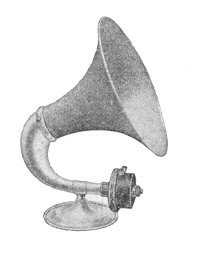
A Bullen 'Bullphone Nightingale'
loudspeaker from 1926. |
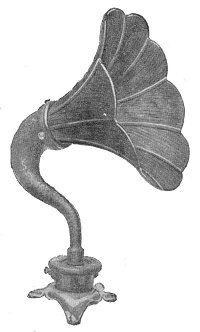
An Amplion 'Swan-neck' De Luxe loudspeaker
from 1926. |
Receivers in those days were extremely
unselective and speech and music required a comparatively large
space on the long wave band. Luckily there was an alternative
entertainment station that broadcasted speech and music. The
Dutch PCGG station started broadcasting in April 1920. Each week
concerts were transmitted on Sunday afternoons, and Monday and
Thursday evenings. Announcements were made in Dutch, French and
English. The first complete wireless receivers appeared in the
UK in 1920. They were made by the British Thomson Houston
Company (BTH). Others introduced in 1921, were manufactured by
Burnham & Company, who later became Burndept, and L. McMichael
Limited. In the USA commercial broadcasting was a great success.
There was a big demand for receivers, and by 1922 many stations
were broadcasting. This fuelled interest in this country, and
manufacturers eagerly wanted to echo the success of their
American counterparts. |
| The Post Office came under pressure to allow
national broadcasting. By the end of May 1922 it had received 23
applications to start broadcasting, and something had to be
done. On 18th May the Post Office met representatives from 18
companies and asked them to come up with a cooperative scheme
for broadcasting. Discussions went on for 5 months without any
proposal. Each company had its own interests and there was much
conflict. The government and the press complained at the delay
and on 18th October proposals were finally put to the industry.
The result was the setting up of the British Broadcasting
Company, which would broadcast from eight transmitters, covering
most of the larger areas of population. Capital was provided by
the six largest companies: Marconi, GEC, BTH, Metropolitan
Vickers, Western Electric and the Radio Communication Company. |
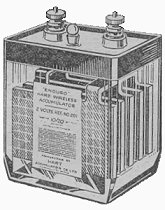
A Hart wireless accumulator from 1926. |
Any British manufacturer or retailer could
become a member by purchasing at least one £1 share. Listeners would buy
a 10 shilling receiving licence and would pay two tarriffs. The first
was based upon the various components in the receiver and went to the
BBC. The second was a levy of 12s.6d per valveholder which went to the
Marconi Co. as a royalty.
| The Technical Details of Valve
Receivers |
 |
|
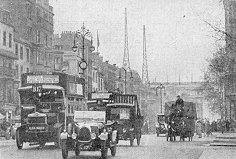
The 2LO aerials that were on the roof
of Selfridges in Oxford Street, London. |
On Tuesday 14th November 1922, the first BBC station
2LO started broadcasting in the Medium Waveband, from the roof of
Selfridges in Oxford Street, London. The next day 5IT started
broadcasting in Birmingham, and 2ZY went on the air in Manchester.
2LO reached an audience of about 18,000. By October all of the
stations were in operation, and reached about half of the
population, with signals that were strong enough to be received by a
crystal set. In July 1925 the BBC opened a high power long wave
transmitter at Daventry, which reached 55% of the population. |
By this time about 85% of the
population could receive the transmissions. Although many
different valve receivers were available from about 1923,
crystal sets remained the most popular receivers for several
years. This was due to their low cost and freedom from the
expensive high tension batteries, and the re-charging of the low
tension accumulators in the valve receivers. The early valves
also had a relatively short life and so needed frequent
replacement. Although crystal sets could only operate
headphones, it was possible to connect several of them to a
receiver so that a family could listen together. By the summer
of 1925, one and a half million receiving licences had been
issued.
In the 1920's and 30's there were large
numbers of radio kits on the market. These were popular as they
were a lot cheaper than the ready built receivers. The receiver
on the right was built from a typical kit. |

|
| Valve receivers had the advantage of being able to
operate a loudspeaker. Initially these were horn loudspeakers,
but soon more modern types were developed which could be housed
in the same cabinet as the receiver, to provide good sound
quality. The early valve receivers were mostly of the tuned
radio frequency (TRF) type, which often had an array of
different knobs and switches on the front panel. Tuning-in a
station required the operation of several controls, and to
change waveband sometimes required the plugging-in of different
tuning coils. Many receivers had a reaction control which
adjusted the sensitivity and selectivity. If this was advanced
too far, the receiver would burst into oscillation and act like
a transmitter, so interfering with everyone else's receiver in
the neighbourhood. |
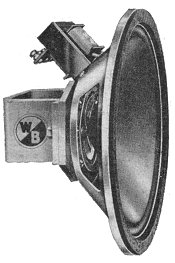
An early moving coil loudspeaker, which
was similar to the modern version. |
|
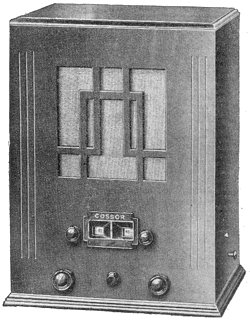
An early Cossor radio. |
The modern type of receiver, which is called a
super heterodyne, or superhet for short, appeared in 1925. This
produced the highly sensitive and selective receiver, with few
tuning controls, that we are used to today. Mains powered
receivers and battery eliminators appeared in 1926. The first
mains powered receiver to entirely dispense with batteries, was
the 'Baby Grand', made by Gambrell Brothers Limited. In those
days mains electricity was provided by hundreds of small
companies which supplied electricity in a variety of different
voltages, frequencies and even D.C. When the national grid was
set up in the early 1930's, it standardised the supply and made
it much easier to produce mains power supplies for receivers. It
also helped to establish mains powered radios. At the end of the
1920's, the number of receiving licences had risen to three
million. |
By the 1930's valves had become very reliable and the
price of receivers had started to fall. The first push button radios
were produced in the mid 1930's, and short wave bands were popular,
which gave the listener access to much of the world. Smaller valves were
developed during the second world war, which eventually gave rise to the
more compact receivers of the late 1940's and early 1950's. Most of the
popular B.B.C. medium and long wave stations that we are familiar with
today, were broadcasting by the late 1940's. The Light Programme (Radio
4) started broadcasting on 29th July 1945, on 1500 metres, in the long
wave band.
| In the 1950's internal aerials became standard and
small miniature battery operated valves were produced for the first
truly portable receivers. In the early 1950's, the BBC began
experimenting with FM, VHF broadcasts, to offer high quality,
interference and noise free reception. The first station officially
opened on 2nd May 1955. The performance of some of
the early FM receivers left a lot to be desired, especially in terms of
the VHF circuitry and FM detection. But soon things improved and FM
receivers became commonplace. In the late 1950's radiograms became
popular, and catered for the rapidly growing interest in records.Valve
radio development ended in the early 1960's as transistors began to take
over. |
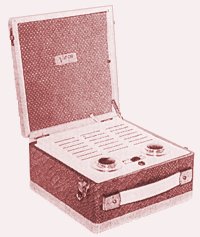
A Vidor valve portable from 1954. |

|
|
 |
| Return to Early
History |
|
Proceed to the
Transistor Era |
|



